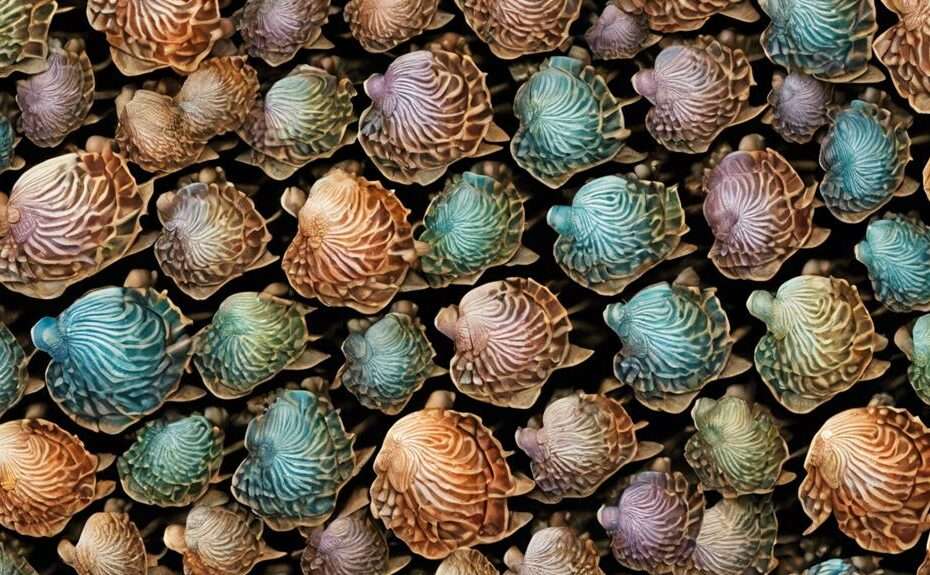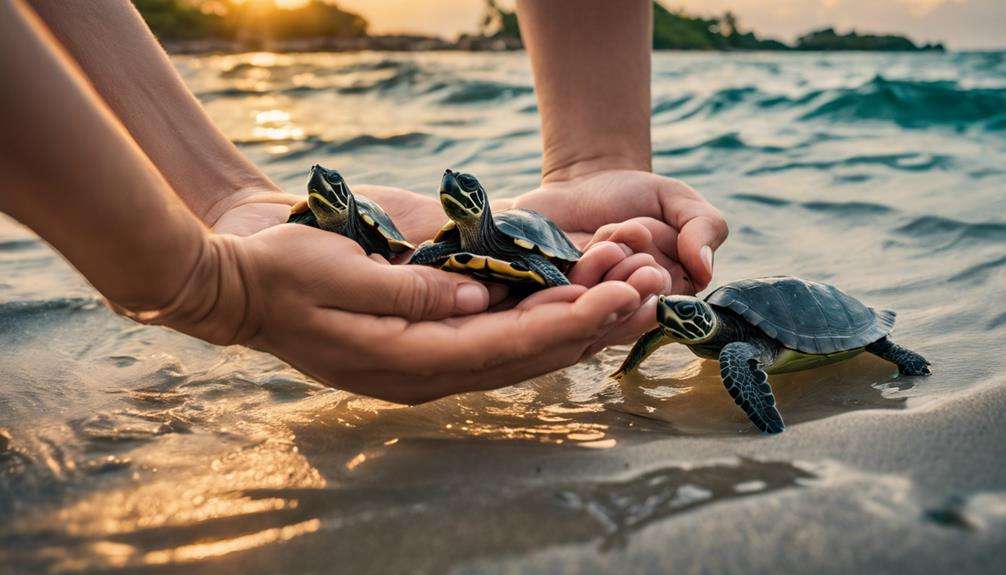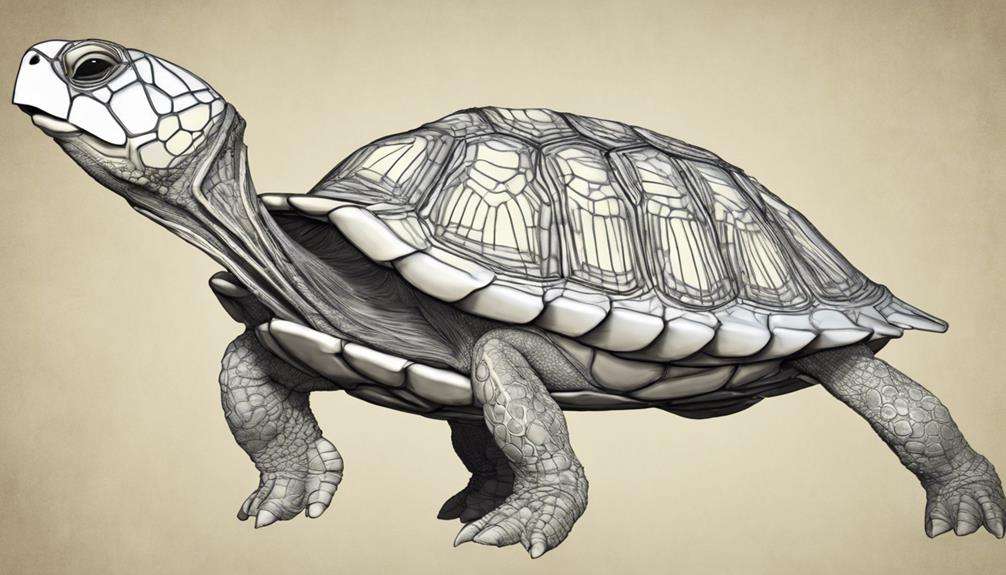Have you ever wondered if the intricate shell patterns of rare turtles hold a secret beyond just aesthetics?
These unique designs are not merely for show; they serve a dual purpose that goes beyond what meets the eye.
As you explore the fascinating world of rare turtle shells, you'll uncover a complex interplay of factors that make these patterns truly special and essential for the survival of these remarkable creatures.
Key Takeaways
- Rare turtle shell patterns reflect millions of years of evolution and provide crucial survival advantages.
- Genetic variations and mutations shape unique shell designs, aiding in conservation efforts and genetic diversity.
- Conservation of rare turtle populations is essential to safeguard their distinct shell patterns and prevent extinction.
- Environmental and cultural influences play a role in developing the special and diverse shell patterns of rare turtles.
Evolution of Turtle Shell Patterns
The evolution of turtle shell patterns is intricately tied to their ecological niches and the selective pressures exerted by their environments. The geometry of their shells, specifically the arrangement of scutes, plays a vital role in their survival. Hexagons positioned at the center of a turtle's shell, surrounded by pentagons and irregular shapes, provide efficient coverage and protection. This unique geometric configuration not only offers structural integrity but also aids in camouflage, allowing turtles to blend seamlessly into their surroundings.
Moreover, the reduction or loss of shell bones in certain turtle lineages has resulted in different shell patterns and adaptations. These adaptations are a direct response to the diverse habitats and challenges faced by each species. The geometry of their shells is a product of millions of years of evolution, fine-tuned to suit the specific needs of each turtle species. Understanding the intricacies of these shell patterns provides valuable insights into the evolutionary history and ecological interactions of these fascinating creatures.
Significance of Unique Shell Designs
Evolutionarily shaped by their ecological niches, rare turtles exhibit distinctive shell patterns that serve as important identifiers within their species. These unique shell designs aren't just essential; they play a pivotal role in conservation efforts aimed at tracking and protecting rare turtle populations.
The intricate patterns on the shells of these turtles aren't random; they serve as a form of camouflage and protection in their natural habitats. By studying these specific shell patterns, researchers gain valuable insights into the evolutionary history and ecological adaptations of these rare turtle species.
Conservationists and biologists rely on these distinctive markings to monitor and assess the health and distribution of endangered turtle populations. Understanding the significance of these shell patterns goes beyond mere visual appeal; it's a fundamental aspect of preserving and safeguarding these rare and remarkable creatures.
Factors Influencing Rare Turtle Patterns
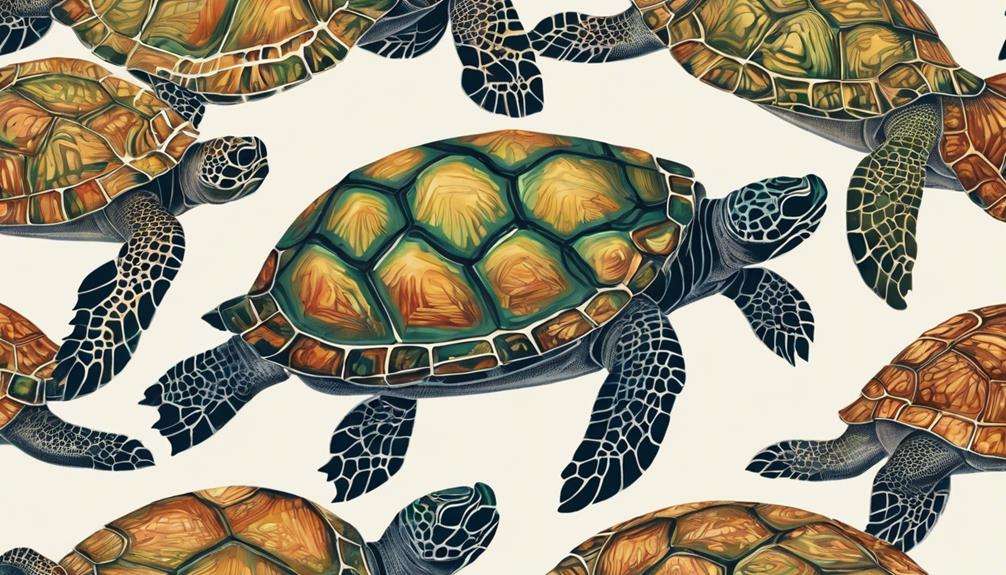
Influenced by genetic variations and environmental factors, rare turtle shell patterns exhibit distinct characteristics shaped by their unique habitats and interactions. The intricate designs seen on the shells of rare turtles aren't just random; they're a result of the genetic makeup of the species. Genetic variations within the population contribute to the diversity of shell patterns observed in these turtles.
Additionally, environmental factors such as habitat type and diet play a significant role in shaping the development of these unique patterns. Interactions with other turtle species and predators further influence the evolution of these distinct shell patterns. The specific functions served by these patterns, such as camouflage, thermoregulation, or species recognition, highlight the importance of understanding the factors that influence their formation.
Conservation efforts are essential in maintaining the genetic diversity and preserving the unique shell patterns of these rare turtles for future generations.
Adaptations for Rare Turtle Survival
Rare turtles exhibit a diverse range of adaptations that contribute to their survival in distinct habitats. One key adaptation is their unique shell patterns, which play a vital role in their ecological survival. These shell patterns aren't just for aesthetic value; they provide essential camouflage, helping rare turtles evade predators and blend seamlessly into their specific environments. By blending in with their surroundings, these turtles increase their chances of survival and reproduction.
These specialized shell patterns are considered ecological adaptations that have evolved over time to suit the specific needs of each rare turtle species. The intricate designs and colors of their shells are tailored to their natural habitats, providing them with a survival advantage. Studying these shell patterns can offer valuable insights into the evolutionary history and habitat preferences of rare turtles, aiding in conservation efforts and species identification. Overall, the shell patterns of rare turtles aren't just beautiful; they're essential tools for their survival in the wild.
Genetic Basis of Exotic Turtle Shells
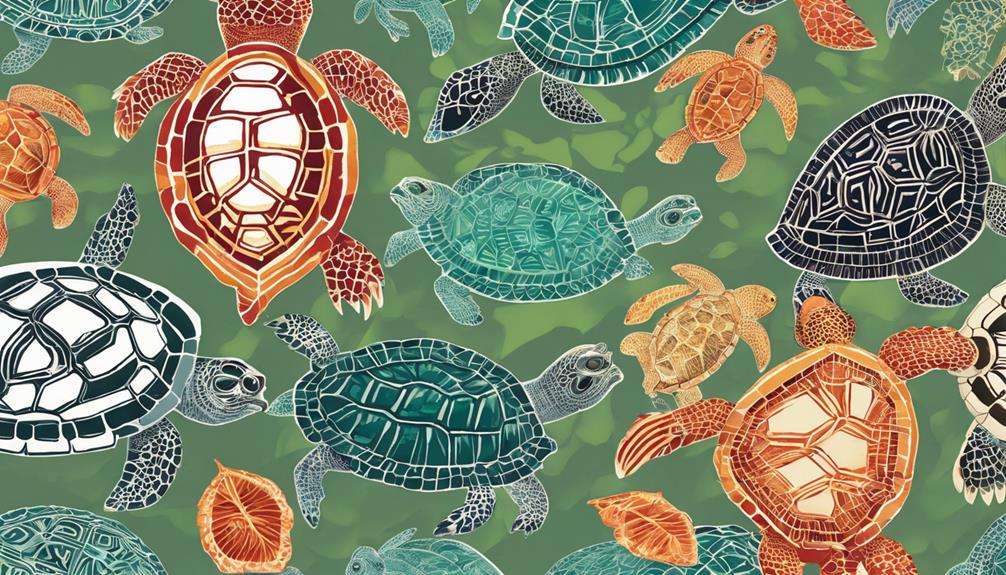
The intricate shell patterns of rare turtles are a result of specific genetic factors that dictate shell color and pattern development.
Genetic variations contribute to the unique designs seen in exotic turtle shells, allowing for species identification and differentiation.
Understanding the genetic basis of these shell patterns is important for conservation efforts and the preservation of these rare turtle species.
Shell Color Genetics
A complex interplay of specific genetic variations in their DNA determines the intricate and exotic shell patterns observed in rare turtles.
The shell color genetics of these unique creatures are governed by a combination of genes that dictate the expression of vibrant colors and intricate designs on their shells. Genetic mutations play a vital role in the development of these stunning shell patterns, contributing to the diversity seen in rare turtle species.
By understanding the genetic basis of shell coloration, researchers can gain valuable insights into the conservation of these extraordinary animals.
The complex interplay of genetic factors controlling shell coloration results in the diverse and enchanting shell patterns that make rare turtles truly special in the world of reptiles.
Pattern Development Process
In the intricate process of pattern development for exotic turtle shells, genetic variations intricately dictate the formation of vibrant colors and elaborate designs, resulting in visually striking and diverse shell patterns.
The genetic factors at play in the development of these shell patterns are essential in determining the intricate details that make each rare turtle unique. Specific genes play a pivotal role in orchestrating the complex pathways that lead to the formation of these exotic patterns.
Through the influence of genetic variations, the shell patterns of rare turtles exhibit a wide array of intricate designs and color combinations. Understanding the genetic basis of these shell patterns sheds light on the evolutionary processes that have shaped these visually stunning and biologically significant features in exotic turtle species.
Conservation Implications of Shell Patterns
The unique shell patterns found on rare turtles play an important role in impacting ecosystems by influencing their camouflage and survival strategies.
These patterns also hold significance in maintaining genetic diversity within turtle populations, thereby ensuring their resilience to environmental changes.
Conservation efforts focusing on monitoring and safeguarding these distinct shell patterns can aid in preventing poaching activities that threaten the existence of these vulnerable turtle species.
Impact on Ecosystems
Rare turtle shell patterns play a pivotal role in shaping ecosystems by serving as unique identifiers for conservation efforts and ecological understanding. These distinctive patterns allow researchers to monitor and identify individual turtles within populations, aiding in conservation strategies.
By studying these shell patterns, scientists gain insights into the ecological roles of rare turtles and their interactions with other species in their habitats. Conservationists utilize these unique markings as a tool to track population dynamics and genetic diversity, essential for the long-term survival of these rare species.
Understanding the significance of rare turtle shell patterns not only benefits the targeted conservation of these specific turtles but also contributes to the broader preservation of the ecosystems they inhabit.
Genetic Diversity Importance
Shell patterns of rare turtles offer valuable insights into the genetic diversity essential for successful conservation efforts aimed at protecting these unique species.
The intricate designs on their shells not only serve as visual identifiers for different turtle populations but also reflect the underlying genetic variations within these groups. By studying the genetic basis of these shell patterns, researchers can gain a deeper understanding of the evolutionary history and adaptive strategies of rare turtles.
Conservation implications of shell patterns underscore the significance of preserving genetic diversity within populations to assure their long-term survival. This knowledge can inform targeted conservation strategies tailored to safeguard the unique characteristics encoded in the genetic makeup of these fascinating creatures.
Poaching Prevention Strategies
To deter poachers and safeguard the rare turtles with unique shell patterns, conservationists implement strategic prevention measures. The distinct shell patterns of these turtles serve as a natural defense mechanism against illegal activities. Conservation efforts heavily rely on leveraging these shell patterns to protect the rare turtles from the threats posed by poaching.
By utilizing the shell patterns as identification marks, conservation organizations can effectively track and monitor populations of these endangered turtles for enhanced protection. Illegal poaching for the valuable shells of these turtles poses a significant risk to their survival in the wild.
Hence, safeguarding these rare turtles and their special shell patterns is essential to prevent their extinction due to poaching activities.
Role of Environment in Turtle Patterns
Influenced by a myriad of environmental factors, the development of unique shell patterns in rare turtles is a complex and fascinating process. The intricate designs and colorations on a turtle's shell can be directly linked to the conditions of its surroundings. For instance, temperature and humidity play important roles in shaping these patterns. Variations in these factors can result in different colorations and markings on the shells of turtles.
Additionally, the availability of resources and the quality of the habitat can contribute greatly to the development of shell patterns. Exposure to sunlight and UV radiation is another environmental aspect that influences the pigmentation and intensity of patterns on a turtle's shell. Changes in water quality and diet further add to the variability in shell patterns among different turtle species.
It's essential to understand the impact of environmental stressors and human activities on disrupting the natural development of these intricate shell patterns in rare turtles.
Rare Turtle Shell Variability
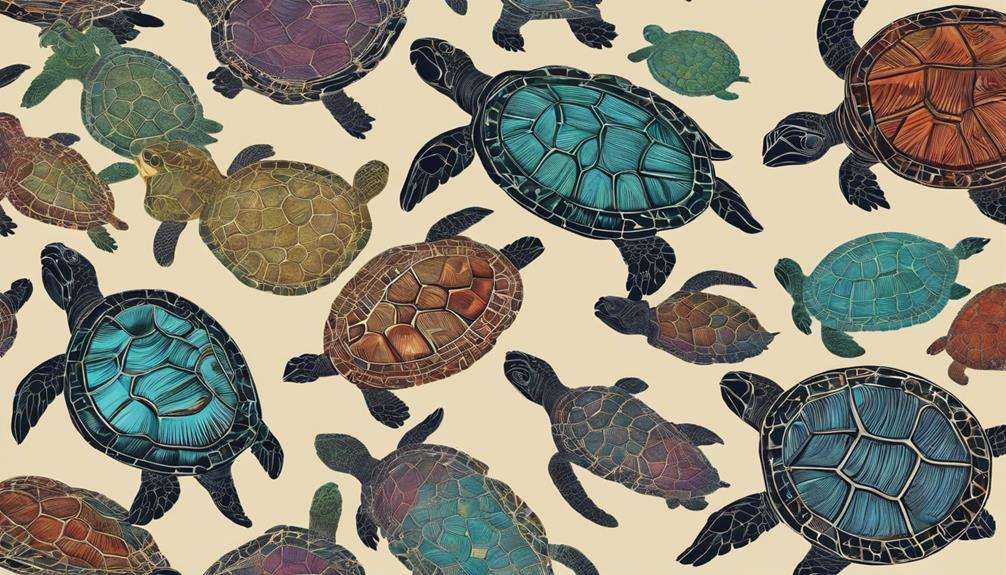
Rare turtles exhibit a remarkable array of shell patterns, showcasing unique color combinations and intricate designs that hint at their genetic diversity and evolutionary history. These patterns are formed by the arrangement of epidermal scutes, which are scales covering the turtle's shell.
Each turtle species has a phylogenetically stable pattern that distinguishes it from others, reflecting its evolutionary lineage. The variability in rare turtle shells can be attributed to rare genetic mutations that lead to distinct patterns not commonly seen in other turtle species.
Conservation efforts are essential to protect these rare turtles and preserve their unique shell variability for future study. By studying these shell patterns, scientists gain valuable insights into the genetic diversity and evolutionary pathways of these rare turtle species.
Understanding the significance of these intricate designs contributes to our knowledge of the natural world and the importance of preserving biodiversity.
Cultural Perspectives on Turtle Shell Designs
Cultures worldwide hold deep-rooted beliefs and traditions surrounding the intricate designs found on turtle shells, viewing them as symbols of strength, protection, and longevity. The epidermal scutes, which are the specialized scales composed of keratin that make up the ectoderm covering the shell, play a fundamental role in the cultural significance attached to these patterns.
In Japanese culture, the turtle shell pattern symbolizes good luck and longevity, reflecting the reverence for these creatures. Similarly, in various other cultures, different turtle shell designs hold significance, representing protection and strength. These intricate designs aren't merely ornamental but are deeply embedded in traditional art and crafts, conveying symbolic meanings that transcend generations.
The admiration for the beauty and uniqueness of these patterns spans across societies, showcasing the profound connection between nature and human beliefs. The cultural perspectives on turtle shell designs highlight the intricate interplay between art, symbolism, and the natural world.
Frequently Asked Questions
Why Do Some Turtles Have Different Patterns on Their Shells?
You see unique shell patterns on turtles due to evolutionary adaptation and genetic variation. These variations result from environmental influences and genetic mutations. The intricate designs serve purposes in camouflage and protection in their habitats.
What Is Unique About the Turtle Shell?
Your turtle shell is a marvel of evolutionary adaptation, serving as both armor and art. Its intricate patterns provide protective camouflage in the wild, blending seamlessly with the environment to shield you from predators.
What Is the Pattern on a Turtle Shell?
You observe the intricate turtle shell pattern, a tapestry of hexagons and pentagons. Understanding evolution reveals this design's role in camouflage adaptation. New scutes overlap, forming a shield that's both protective and visually striking.
Why Do Turtle Shells Have Hexagons?
Turtle shells have hexagons for evolutionary adaptation. The pattern enhances structural integrity and serves as camouflage. As new scutes overlap, the hexagonal design emerges. Its uniqueness aids in identification and protection, making it special among turtle species.
Conclusion
To sum up, the shell patterns of rare turtles are like intricate works of art, serving as both a form of camouflage and a means of identification.
These unique designs have evolved over time to help these turtles survive in their natural habitats, reflecting the genetic diversity and adaptability of these fascinating creatures.
Understanding and preserving these special shell patterns is vital for the conservation of these rare turtle species in the face of environmental challenges.
